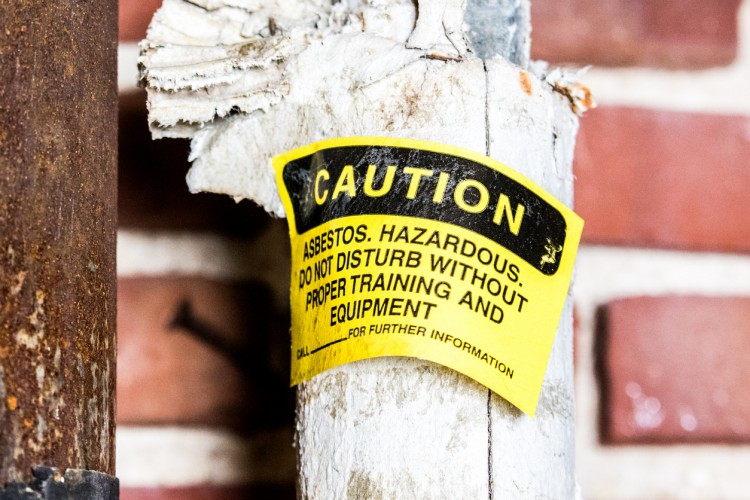Hearing the word asbestos can be a scary one, especially since it has a negative connotation. So let’s dive a little deeper into understanding what it’s like selling an asbestos-containing home; and the real truths behind it.
Many homes in the US still have asbestos. Don’t be alarmed, asbestos-containing houses can still be sold.Let’s take a closer look at the question and find out how it works.
Can you sell a house with asbestos?!
In short, you are able to sell your home if it has any asbestos components.
The US used thousands of asbestos-containing products up until the 1980s. This includes products used in residential construction such as siding, insulation, and tiles.
More than half of single-family homes in America that are currently occupied were built before 1980. Homes made from asbestos are legally being bought and sold daily, as you might imagine.
There are two options available to homeowners who have asbestos in their homes. The first is to repair the asbestos problem and then market the house to the public in the normal way. Another option is to simply sell the property as it stands.
Are You Required to Disclose Asbestos When Selling a Home?
There are many rules that govern seller disclosure of material facts depending on where the property is located. They all point to full disclosure of asbestos’s presence. Be sure and get with your real estate agent; they should have the experience that will need to be addressed before you begin the selling process.
Many states require you to disclose asbestos-related information in your home. It is important to determine if your state is one.
Even if there is no asbestos disclosure law in your state, it may have other disclosure requirements that buyers or their attorneys could believe would include asbestos.
Many states have a Residential Property Disclosure Form that asks you to disclose if the house contains toxic or hazardous substances. You might also be asked if there are any environmentally hazardous conditions at the property by other states.
Buyers could expect that the answers to these questions would include asbestos’ presence, regardless of whether the form includes it as an example.
Except in very rare states sellers must inform buyers about any facts that could affect the sale of their property. This broad requirement could be taken to include asbestos.
You can answer the question honestly, regardless of where you live.
Your buyer may be suspicious if they discover that your home contains asbestos. This could end your conversation with the buyer (and cause the sale to fall through).
Is Asbestos a possibility during a home inspection?
To determine if a material has asbestos, home inspectors must perform a microscopic inspection of a sample taken from drilling or other destructive actions. This requires the owner’s approval. A typical home inspection will not find asbestos in a home.
Inspectors are able to identify asbestos used in older homes. Inspectors will warn homeowners if they find asbestos-containing components in homes built before 1980.
The possibility that asbestos may be present in the property will be noted by appraisers.
An EPA-certified asbestos inspector would make the final determination.
Asbestos exposure is most dangerous and can cause health problems when fibers are inhaled in the lungs, so it is important to take precautions to avoid disturbing any materials that may contain asbestos.
What the Negotiation Process Looks Like with Buyers
Buyers might believe asbestos is harmful, or may view it as an opportunity for a lower price. You can expect buyers to request a credit or a decrease in price due to asbestos.
Sometimes, the perception of the danger of asbestos in a house is worse than the actual danger (that’s a good thing). Asbestos exposure can cause a variety of serious health problems, including lung cancer, mesothelioma, and asbestosis.
Although asbestos can have serious health effects, it doesn’t cause any harm until it is removed.
Asbestos fibers can be released into the atmosphere when asbestos-containing materials are broken down or cut open. This can happen through demolition, sawing, drilling, or drilling into these materials during renovations. People can inhale or inhale fibers when this happens.
Asbestos products can be solid and pose little danger to the home’s occupants if they are not disturbed. Insulation and other materials are more susceptible to becoming friable or airborne.
The buyer can manage the risk by ensuring that the asbestos materials are not too dense or hard. This greatly reduces the real danger of being exposed.
Remediation can often be used to neutralize these types of asbestos. Remediation is less expensive than removal, and the price would not drop as much.
You can legally point out to the seller if asbestos is in a less hazardous form during negotiations in order to minimize your impact on the price.
Where are the Places to Find Asbestos in a Home?
You may find asbestos in more than 1 place in your home.
Many industries used asbestos because of its many benefits. Asbestos is light, fire-resistant, heat resistant and can be added to paint products with tensile strength. According to the EPA, asbestos can be found in many places in your home
– Ceiling tiles and ceiling panels
– Insulation in the attic and walls
– Roofing underlayment
– Siding Shingles
– Exterior siding
– Soundproofing or decorative wall panels
– Steam Pipes coated with asbestos
– Texture paint applied on the ceilings and walls
– Vinyl floor tiles
What is the cost to remove or remediate asbestos from a house?
If asbestos is found in your home, you may be able to have it removed by a certified asbestos abatement contractor. To determine if you need to remediate or remove asbestos materials, an EPA-certified inspector will first inspect your home. The cost of this inspection will be over $400 but less than $800. This will vary depending on what lab work is required.
The cost of testing for airborne asbestos particles is not included in this price.This will increase inspection costs by $400-$1000.
After the work is completed, a final inspection will be required. It can cost anywhere from $200 to $400.
There are many regulations that govern the disposal and removal of asbestos materials.Remediation is more costly than removal. Remediation’s purpose is to keep the material contained so that it doesn’t get disturbed.
Insulation is the most costly material to remove because it can easily become airborne. The cost of removing attic insulation could run from $10,000 to $25,000, or more.
The cost of removing solid materials such as tile and drywall can run to several thousand dollars per room. To remove asbestos paint from pipes, it can cost as much as $5,000. The cost to remove all siding from a house is anywhere from $12,000 to $16,000
Most companies will only charge for small jobs, which could range from $2,000 to $3,000 depending upon where you are located.
Remediation can be up to 25%-30% less expensive than removal.
The Best Way to Sell a House With Asbestos
Who will buy my home with asbestos as it is?
Selling a house that is in need of repairs would save you all the hassles, but a buyer who intends to live there will likely not be able to afford it.However, there is a buyer who will not only consider purchasing your home as-is but they are actively searching for properties similar to yours.
Real estate investors can be either individuals or companies. They buy houses quickly and pay cash to rent or resell them. This is known as “house flipping”, which involves fixing up the house and selling it immediately. Others prefer to fix up the house and make it a rental property.
Investors make business decisions when buying houses without having to deal with the emotions that may be associated with homebuyers. They will be able to see an issue like asbestos objectively.
Properties that require repairs or renovations similar to yours are the best properties for their intended uses.This saves you money as they can handle the renovations themselves. Sometimes, they do the work themselves.
Investors have cash and don’t have to borrow money for the purchase. This allows the seller to avoid being dependent upon the buyer’s mortgage lender, who might not approve them for a loan on a home with asbestos problems.
Local real estate professionals can assess the viability of a project by comparing market values and repair costs.Sometimes they are accompanied by their workers to conduct their own inspections.
Benefits of selling your house to a real estate investor
These steps can be used to sell your house to a buyer who is not a real estate investor.
– The cost of asbestos removal and remediation in your home will not be charged to you. This cost will be included in the cash offer of the investor.
– The process is much quicker than traditional sales because the investor handles all the details.
– All-cash purchases of your home eliminate the need for the lender’s approval and reduce the chance that your buyer is denied.
– This saves you the effort and money of advertising your home to the general public.
– You should leave your home during shows and wait to find a buyer who isn’t afraid of asbestos.
– You won’t be required to pay any closing costs, including commissions, if you sell to an investor.
Investors need to purchase homes below their market value to maximize their profit margins. This is why they seek properties that are in need of work .Investors will not pay the market price for your home.
Selling to a real investor might be the best choice for you, depending on your motivation and your circumstances.
Frequently Asked Questions
What are the health risks associated with asbestos?
Exposure to asbestos may increase the risk of developing mesothelioma, a rare but aggressive cancer that forms in the lining of the lungs, abdomen, or heart.
What is asbestos?
Asbestos is a naturally occurring mineral that has been used in a variety of construction materials for its heat-resistant and fire-resistant properties. However, exposure to asbestos fibers can cause serious health problems, including mesothelioma.
How common is asbestos in houses?
Asbestos is not commonly found in houses built after the 1980s. However, it may still be present in older homes, especially in insulation, flooring, and other construction materials.




